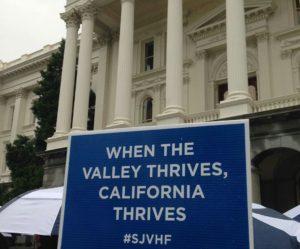By Hannah Esqueda
Photos via MOP
Residents from across the San Joaquin Valley gathered for a day of action in Sacramento last week to draw attention to social and environmental injustices present throughout the region. From discriminatory housing policies to the presence of pesticides and toxic chemicals near local schools, advocates called upon state legislators to protect Valley communities and create a “golden state for all.”
Billed as “Equity on the Mall,” the advocacy event drew hundreds of residents and families of color from towns across the Valley who braved rain and stormy weather to assemble on the steps of the state capitol building. Organizers hoped to engage with legislators on issues affecting their communities and express support for several key pieces of legislation, including Senate Bill 54.
Introduced last year by Senate President Pro Tem Kevin de Leon, the bill seeks to establish California as a sanctuary state, prohibiting the use of state or local public resources for Immigration and Customs Enforcement (ICE) proceedings.
De Leon spoke during Equity on the Mall, reassuring the undocumented and other residents who felt targeted by recent federal policies.
“California will never abandon you; not today, not tomorrow, not forever,” he said.

Organized by the San Joaquin Valley Health Fund (SJVHF), the capitol demonstration also built upon key findings from a recent report on the prevalence and effects of child poverty in the Valley.
Released in January, the report includes extensive research conducted by the University of California, Davis Center for Regional Change and calls attention to the extreme inequities present in low-income communities of color throughout the Valley. The study also points out that one in five Valley children have at least one undocumented parent, making immigrant rights a vital topic for area communities.
According to the study, “the San Joaquin Valley is one of the fastest growing regions in California, and is the center of the state’s vital and prosperous agriculture industry, but it will not reach its full potential until and unless all of its children have the opportunity to thrive.”
Agriculture and the food processing industry dominate the region’s economy, both of which rely heavily on low-wage and seasonal workers. The SJVHF report points out that poor working conditions are a frequent reality for many immigrant Valley families, often creating a cycle of poverty that proves difficult to break.
According to the study, eight of the nine counties within the Valley are consistently ranked among the top 10 agricultural producers of the state, yet seven of the very same counties suffer from some of the highest rates of child poverty anywhere in California.
As a result, one in three Valley children are listed as living below the Federal Poverty Line — calculated at $24,008 for a family of four in 2014. Children of color are particularly vulnerable to this trend, according to the report, as a bevy of discriminatory practices and inadequate social support systems have resulted in them living within the poorest Valley communities.
Over the years, this has led to a concentration of childhood poverty within the region that is difficult for most to climb out and break free from, according to researchers.
Boys and children of color are particularly vulnerable to a disadvantaged childhood environment, as researchers found they are more likely than girls or white counterparts to suffer negative impacts on high school graduation and adult earnings.
Environmental factors like air pollution and exposure to pesticides were also highlighted in the study, with researchers finding the Valley’s low-income communities to be disproportionately affected.
Merced County faces some of the highest environmental health burdens, with more than 32 percent of area children diagnosed with asthma — double the statewide average of 15.4 percent. San Joaquin, Kings and Fresno counties also scored higher than average, with a diagnosis rate of 22.9, 22.3 and 21.3 percent, respectively.
SJVHF and partner groups say they hope the report will be motivation to address these and other inequalities at the state- and regional- level rather than just locally.
According the report: “the San Joaquin Valley’s generally conservative political culture tends to favor a local control perspective that cuts against efforts to promote regional and collaborative planning and governance efforts.”
The report further identifies Valley residents as one of the region’s top assets, saying there is an immediate need to protect them and the area’s future.
Attendees at the Equity on the Mall event agreed and called for Valley representatives to support bills like SB 54 that will offer sanctuary for the undocumented and their families.
“We want our state representatives to know that our community supports this bill as an important part of protecting everyone in our community,” said Crissy Gallardo, community organizer with the Merced Organizing Project, a branch of People Improving Communities through Organizing (PICO) California.
The need for social, political and environmental equality within the Valley is immediate, and according to the report, the Valley’s population is projected to grow even more diverse in the coming years.
The region’s Asian and Latino populations are expected to grow particularly rapidly, and researchers estimate the Valley’s total population jumping from more than 4 million to 7.4 million by 2060.
 Translate
Translate
